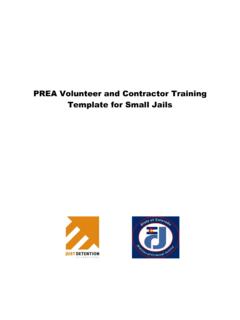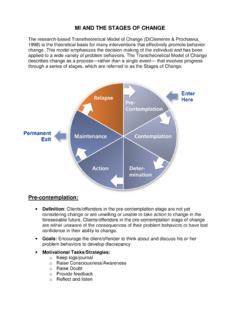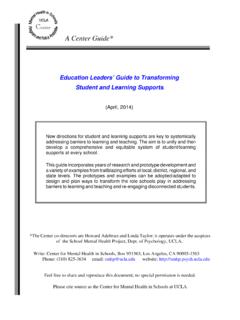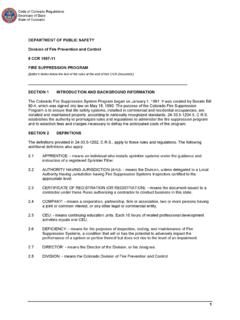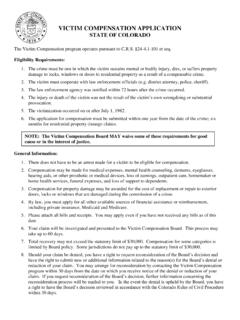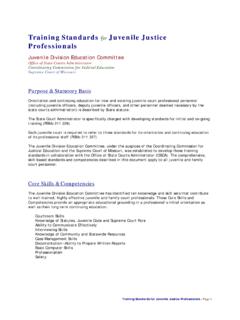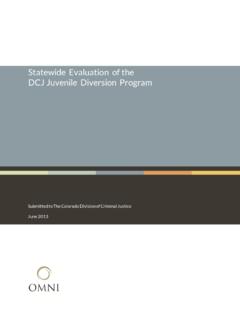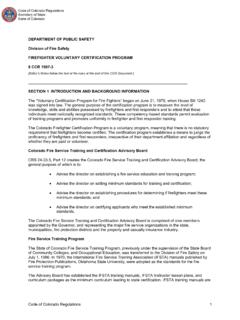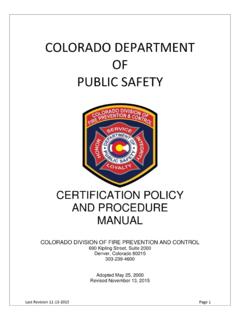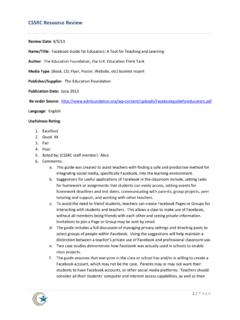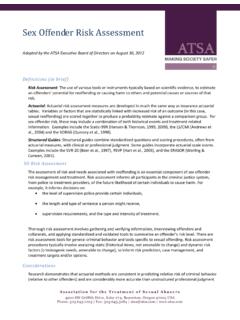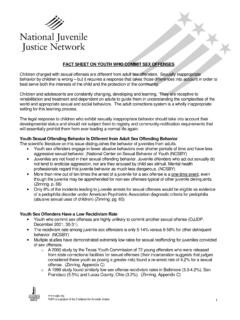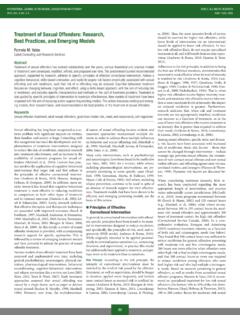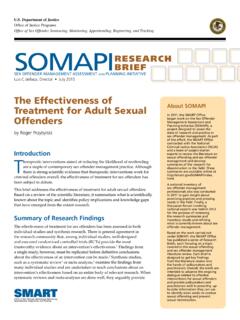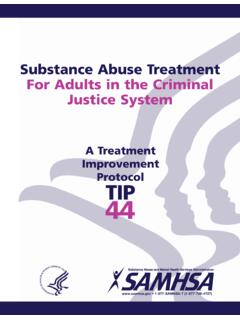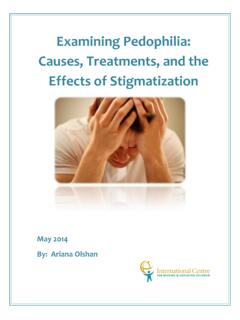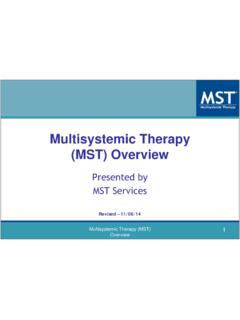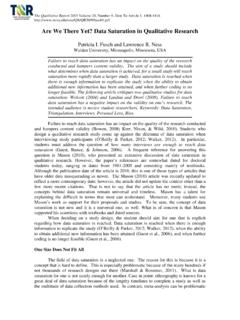Transcription of STANDARDS AND GUIDELINES FOR THE ASSESSMENT, …
1 COLORADO DOMESTIC VIOLENCE offender MANAGEMENT BOARD STANDARDS AND GUIDELINES FOR THE ASSESSMENT, EVALUATION, TREATMENT, AND BEHAVIORAL MONITORING OF DOMESTIC VIOLENCE OFFENDERS Colorado Department of Public Safety Division of Criminal Justice Office of Domestic Violence and Sex offender Management 700 Kipling Street, Suite 3000 Lakewood, CO 80215 (303) 239-4442 1 (800) 201-1325 in Colorado only Colorado Domestic Violence offender Management Board STANDARDS and GUIDELINES for Domestic Violence Offenders 2 Table of Contents Domestic Violence offender Management 5 Historical 7 Guiding 8 offender 13 Referral for offender Evaluation 13 Parameters of the offender Evaluation .. 14 Pre-Sentence offender Evaluation (PSE).. 15 Post-Sentence offender Evaluation .. 16 Required Minimum Sources of 16 Domestic Violence Risk and Needs Assessment Instrument (DVRNA).
2 18 Formulation of Treatment Recommendations, Alternative Options, and 18 Required Minimum Reporting Elements for Submittal to the Multi-Disciplinary Treatment Team (MTT).. 27 Ongoing Assessment and Updating offender Evaluations .. 28 offender 30 Basic Principles of 30 Multi-disciplinary Treatment Team (MTT).. 30 Treatment 33 Development of Individualized Treatment Plan and offender 33 Levels of 35 Required Treatment Plan Review Intervals For All 40 offender 42 offender 48 Couple s 53 Overview Chart of offender 54 offender 61 Victim 63 Treatment Provider 63 Role of Treatment Victim 64 Qualifications for Treatment Victim Advocates Working with an offender Treatment 64 Initial and Ongoing 67 Required Approved Treatment Provider and Treatment Victim Advocate Coordination and 68 Treatment Victim Advocacy and the Multi-Disciplinary Treatment Team (MTT).
3 70 Victim 72 Documentation and Record 75 Colorado Domestic Violence offender Management Board STANDARDS and GUIDELINES for Domestic Violence Offenders 3 Coordination With Criminal Justice 76 Provider 79 General Requirements for All 81 Provisional Level Provider 82 Entry Level Provider 85 Full Operating Level Provider 88 Domestic Violence Clinical Supervisor 92 Specialized Pre-Sentence Evaluator Status .. 96 Specific offender Populations .. 97 Application Requirements Reference 99w Administrative 100 103 A. DVOMB Statement Regarding the Evaluation and Treatment of Non- Justice Involved Domestic Violence 104 B. Overview for Working With Specific offender 105 C. Glossary of 114 D. Administrative 122 E. Resource and Guide to Terms and Concepts of the Pre-Sentence or Post-Sentence Evaluation 133 F.
4 147 G. Domestic Violence Risk and Needs Assessment Instrument (DVRNA).. 150 H. GUIDELINES for Promoting Healthy Sexual 191 I. Interactive Electronic 201 J. Working with DV Offenders Involved in the 203 K. GUIDELINES for Young Adult 207 221 Colorado Domestic Violence offender Management Board STANDARDS and GUIDELINES for Domestic Violence Offenders 4 This page is intentionally left Domestic Violence offender Management Board STANDARDS and GUIDELINES for Domestic Violence Offenders 5 Domestic Violence offender Management Board 1. Introduction to the Domestic Violence offender Management Board The Colorado Domestic Violence offender Management Board (hereafter Board) was created by the General Assembly in the Colorado Department of Public Safety in July 2000 pursuant to , The legislative declaration in the Board s enabling statute states that the consistent and comprehensive evaluation, assessment, treatment and continued monitoring of domestic violence offenders at each stage of the criminal justice system is necessary in order to lessen the likelihood of re-offense, to work toward the elimination of recidivism and to enhance the protection of current and potential victims ( )1.
5 The Board was charged with the promulgation of STANDARDS for the evaluation, assessment, treatment, and monitoring of domestic violence offenders defined in , (hereafter STANDARDS and GUIDELINES ) and the establishment of an application and review process for approved providers who provide services to domestic violence offenders in the state of Colorado. The evaluation, assessment, treatment, and behavioral monitoring of domestic violence offenders shall only be provided by those individuals whose name appears on the DVOMB Approved Provider List pursuant to (1). The Board is committed to carrying out its legislative mandate to enhance public safety and the protection of victims and potential victims through the development and maintenance of comprehensive, consistent and effective STANDARDS for the evaluation, assessment, treatment and behavioral monitoring of adult domestic violence offenders.
6 The Board will continue to explore the developing literature and research on the most effective methods for intervening with domestic violence offenders and to identify best practices in the Purview of the DVOMB I. Pursuant to (4)(a)(II) , the DVOMB STANDARDS and GUIDELINES apply to adult domestic violence offenders who have committed a crime, the underlying factual basis of which has been found by the court on the record to include an act of domestic violence, and who are placed on probation, placed on parole, or placed in community corrections ( direct sentence, DOC inmates occupying state funded community correction beds), or who receive a deferred judgment and The DVOMB STANDARDS and GUIDELINES apply to post-conviction and pre-sentence offender Domestic violence convictions pursuant to local municipal codes are not explicitly included in the DVOMB statutory mandate, but evaluation and treatment pursuant to the STANDARDS and GUIDELINES can inform these cases as a guide.
7 II. There may be other individuals in need of evaluation, assessment, treatment, and 1 Although the term assessment does not appear in , the DVOMB has included this term as part of the treatment process defined by the DVOMB STANDARDS and GUIDELINES pursuant to (4). 2 For more information about the Board, membership, and mandates, please see the DVOMB By-laws. 3 Pre-plea matters are not subject to the purview of the DVOMB STANDARDS and GUIDELINES . 4 (1)(b), Partners in Change v. Domestic Violence offender Management Board, within the Division of Criminal Justice of the Department of Public Safety of the State of Colorado, Case Number 06cv10083 Colorado Domestic Violence offender Management Board STANDARDS and GUIDELINES for Domestic Violence Offenders 6 supervision who do not meet the statutory definition of a domestic violence offender or are not under the jurisdiction of the Colorado criminal justice system.
8 Approved Providers should consider the use of the DVOMB STANDARDS and GUIDELINES as a best practice guideline and at their discretion for cases that do not fall under the purview of the DVOMB. For more information, please see Appendix A. III. The DVOMB STANDARDS and GUIDELINES use a variety of terms referencing persons who are subject to these STANDARDS . The terms that are frequently used in the STANDARDS include domestic violence offender , offender , and client. These terms of reference are used in different sections of the STANDARDS based on the focus of a given section ( , treatment, supervision, etc.), as well as the preferred language of professional stakeholders who frequently reference that section. The DVOMB notes that the use of the term domestic violence offender is consistent with the statutory definition identifying a person who committed a crime, the underlying factual basis of which has been found by the court on the record to include an act of domestic violence.
9 However, the DVOMB recognizes that the use of the term domestic violence offender is in no way intended to label individuals by their behavior, or suggest that those who undergo treatment cannot live a violence and abuse free life-style. General Overview of the Evaluation and Treatment Process I. Upon order by the Court or Parole Board, an offender is required by statute to receive an evaluation and attend treatment as The offender evaluation will result in treatment recommendations that assess the offender s need for treatment, determine what type of treatment is needed, and identify the initial risk level and any additional needs the offender may have related to containment, stabilization and safety (Section ). Please refer to the Figure 1 below for a visual depiction of this process. 5 18-6-801(1)(a) Colorado Domestic Violence offender Management Board STANDARDS and GUIDELINES for Domestic Violence Offenders 7 II.
10 Treatment is the comprehensive set of planned therapeutic experiences and interventions designed to assist the offender in changing any power and control dynamics, abusive thoughts, and behaviors (Section ). Treatment requires the offender to attend in-person group or individual sessions at a minimum of once a week or more depending on the offender s treatment level (Section ). Treatment is individualized and progress is assessed during a Treatment Plan Review (TPR), which occurs every two to three months (Section ). The degree to which an offender progresses in treatment and remains compliant is based on meeting goals associated with the core competencies rather than the passage of a specific amount of time or sessions (Section ). III. Progress through treatment and victim safety is monitored by the Multi-Disciplinary Treatment Team (MTT) consisting of the Approved Provider, the supervising officer, a Treatment Victim Advocate (Section ), and any other adjunct member of the MTT (Section ).
